Pawscessories is reader-supported. When you buy via links on our site, we may earn an affiliate commission at no cost to you.
Learn more.
If you live in a multi-pet household, then you’ve probably seen a few sibling rivalries. You bring new toys into your home and both dogs want the same toy so a fight breaks out in your home.
Since you’re here you’ve likely experienced this and are looking to find out how to stop your dogs from fighting over toys, food, and probably a few other things.
Dogs can fight over a multitude of things and for different reasons. Most of which are driven by normal canine habits.
Depending on your dog’s breed and personality there are specific dogs more inclined towards fighting. Even the nicest dogs can battle it out with siblings over food, toys or even over you!
This can be a nightmare to deal with leading to yelling, screaming, and pleading with your dogs to play nice.
You might be at the point where you don’t remember the last time they didn’t fight over something…
Here’s the good news, you can completely achieve a calm and happy house where all dogs are content.
Let’s dive further into why your dogs are fighting at home.
Table of Contents
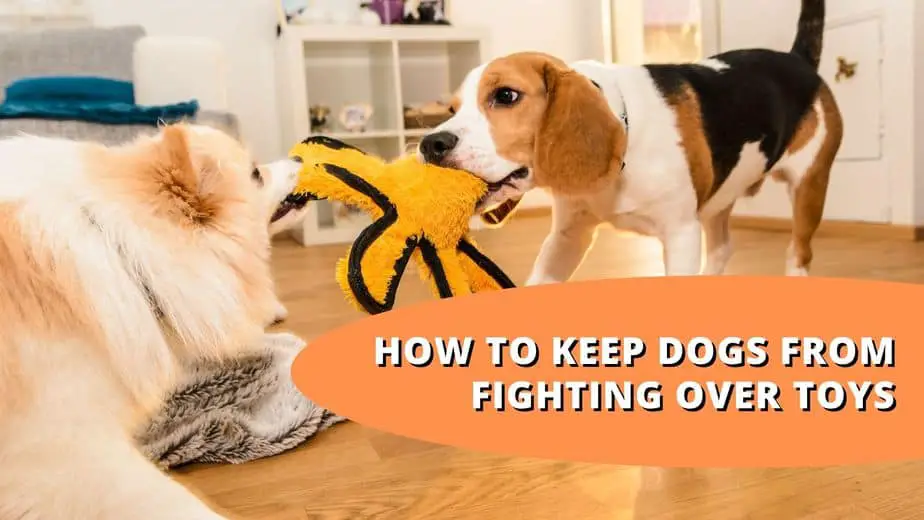
Why Dog Dogs Fight In The Same Household?
Firstly, we need to figure out why your dogs are being possessive and fighting each other in the first place. We need to dive into the mind of your pups.
Are they fighting with intent to harm? Are they trying to solve a conflict without harm?
If we think back historically, dogs are the direct descendants of wolves.
Wolves are raised in packs. When two wolves from the same pack fight this could deeply impact the group. This is becasue they are all dependent on one another to survive.
Thus, they had to find a way to solve conflict without harming one another. Today dogs are no longer wild animals, however, the instinct not to harm each other should still be there.
As puppies they learn early on how to interact and socialize with their “words” rather than hurting one another. However, this doesn’t mean there was never wrestling matches or play biting.
In addition, wolves may also battle from time to time to determine the order of the pack. This could also be reflected in our domesticated dogs as they establish their ranking in the family.
The last point I will mention is wolves in the wild needed to be possessive over their resources in order to survive. So dogs fighting in the same household could come from your dogs thinking they need to protect their resources.
Why Are Dogs Possessive Over Toys, Food, Or Other Things?
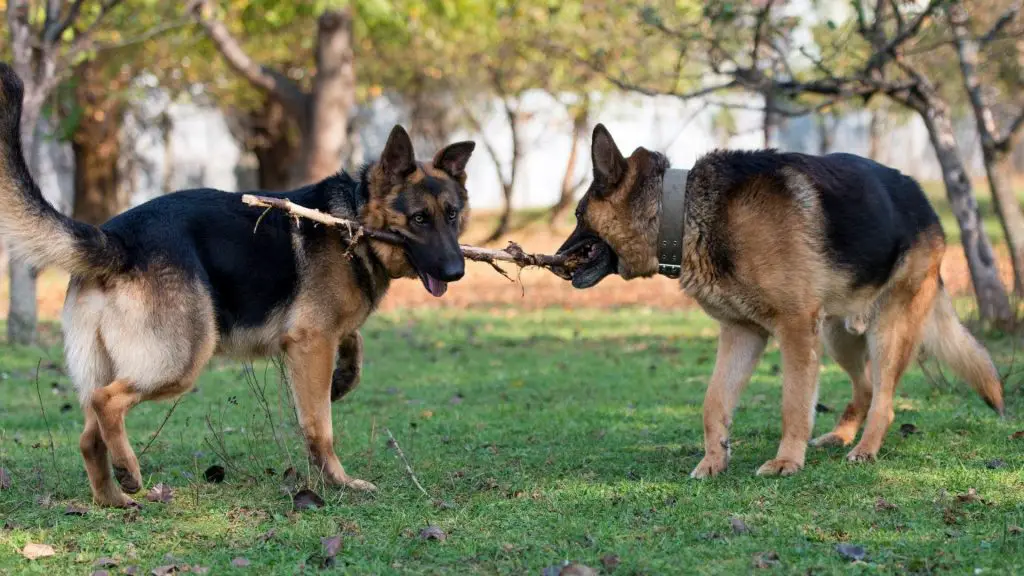
There are many reasons your pup can become possessive over toys and other resources. As I mentioned, wolve become possessive over resources for survival.
Although this is a useful habit for a wild animal, it is not needed in your home and needs to be managed before it becomes a serious problem.
Here are a few reasons dogs become possessive at home and fight over food, toys, and other things:
Acquired Behavior
Some pups learn resource guarding at a young age from their mothers or brother and sisters. Even puppies a few weeks old can show signs of resource guardian over food and toys.
Shelter Dog Syndrome
Dogs that spend a large majority of time in shelters can sometimes develop problems with possessive aggression towards toys and food.
This is definitely not uncommon as other shelter dogs are seen as competition.
Territorial Aggression / Asserting Dominance
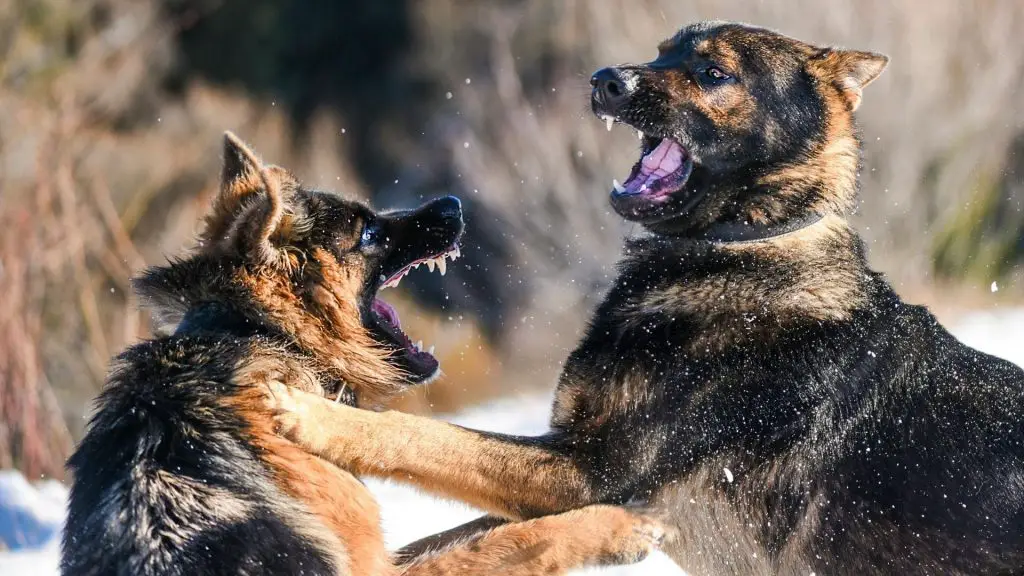
If you have a single dog in your home and you introduce a new dog to the mix this can cause sudden changes in your pup.
Aggression over food and toys may begin to occur and is not uncommon for the first little while of adaptation.
There always needs to be a pack leader and hierarchy. If the dogs in your household haven’t established a stable hierarchy, they’re going to keep fighting it out until they agree.
Furthermore, dogs are territorial so when you throw a new dog into the mix, your pup starts to see this new dog wandering all over their territory without permission.
This issue can be particularly noticeable with instinctually territorial breeds like Schnauzers, Doberman Pinschers, German Shepherds, Rhodesian Ridgebacks, Rottweilers, and Bull Mastiffs
Overstimulation
What can often start out as a friendly fight over a toy can quickly escalate into something much more nasty when dogs get overstimulated.
Play fighting and wrestling is fun for dogs! However, when both dogs become overstimulated this build up of energy can turn a play fight into something nasty.
So now that we know why dogs fight and why they become possessive how
How To Stop Dogs From Fighting In The Same Household
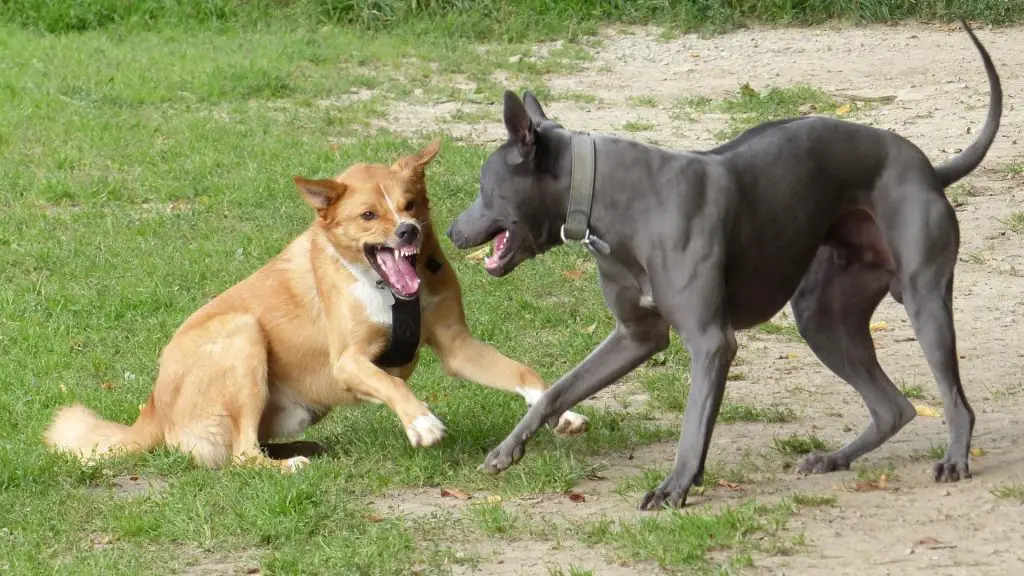
Are your dogs fighting over food? Or maybe your dogs are fighting over toys? Whatever might be causing it this section will teach you how to prevent dog fights in the same household.
Here are a few steps on how to stop dogs fighting over food, toys and everything else in the same household.
Step #1: Develop a plan!
Have a plan in place to avoid fights from escalating.
A great option is to train cues that tell both dogs to pay attention to you. This can be easily done with special rewards for following your command cue.
Have a secondary plan in place to interrupt dogs fighting should it actually occur. A good idea is to have something that will make a loud noise handy.
That way if a fight breaks out you can make a loud noise to distract your dogs from each other. Then, immediately redirect them to another activity.
Step #2: Supervise
If you are noticing certain toys and items are causing fights make sure to supervise your dogs when they are around these things.
Now since you created a plan in step one you know exactly what to do when aggression develops.
When fights do break out interrupting them with loud noises typically works. If however it does not, you can try water, or throwing blankets over them.
Don’t physically separate them unless you have to. In some cases you may just have to keep them separated when playing with toys.
Step #3: Determine If They Are Actually Fighting
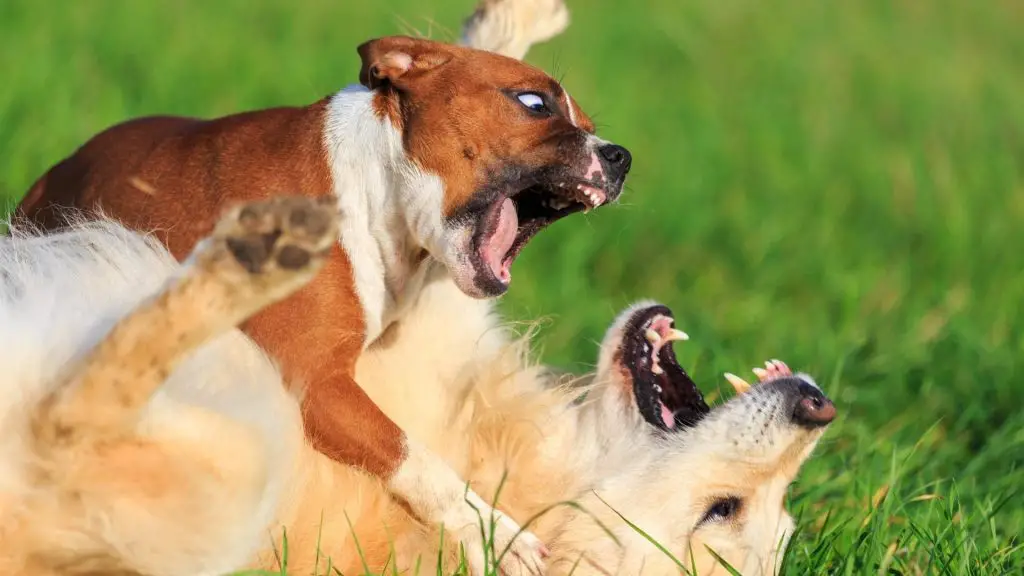
You can typically tell by body language if it’s a real fight or just a friendly engagement. Dogs use teeth (and growls) to play, so it may seem more aggressive then it actually is.
Are your dogs rigid and stiff, or more relaxed, bouncy, and tail wagging?
If they seem more intense, stiff, and rigid it’s likely an actual fight.
Step #4: Train Basic Obedience
Teaching dogs basic commands can help give you more control over these types of situations. A great habit to get into is rewarding your dogs for calm behaviors’.
The earlier you start this type of training the better. Commands like “Gentle” and “off” can be great for taking control of situations.
Here is an example, when you first bring out toys make sure both dogs are calm, sitting and waiting for your command, reward them for doing so.
If they start to get aggressive with each other, remove the toy. This should be something you do even when letting them outside or eating.
Step #4: Desensitization And Counter Condition

If we want to create permanent fixes we need proper training for each dog. The best way to explain how desensitization and counterconditioning can work is to give an example.
To start, get one of their secondary toys (not their favorite). Then place the toy in one hand and a high value treat in the other hand.
If they want the treat, they will have to release the toy to you. Once they finish eating, they get the toy back.
Keep repeating this exercise as often as possible, and eventually work your way up through the ranks of toys until you reach their favorite toy.
A key to this exercise is to make sure the treats are more valued then the toy. Over time, you’ll eventually create an association with giving up the toy with something good happening.
Step #5: Spay/Neutering
Spaying or neutering can be a great calmer. You can notice a large drop in aggression with dogs after they get fixed.
It may sound like an expensive and dramatic solution, but unless you are a breeder, it can be the fix you need.
Step #6: Consult A Professional Trainer
Help from professional dog trainers will always give an edge when it comes to stopping dogs from fighting in the same household.
If you have tried it all yourself and cannot solve the problem, getting some professional help is the best way to get guaranteed results.
How To Get Dogs To Get Along After A Fight
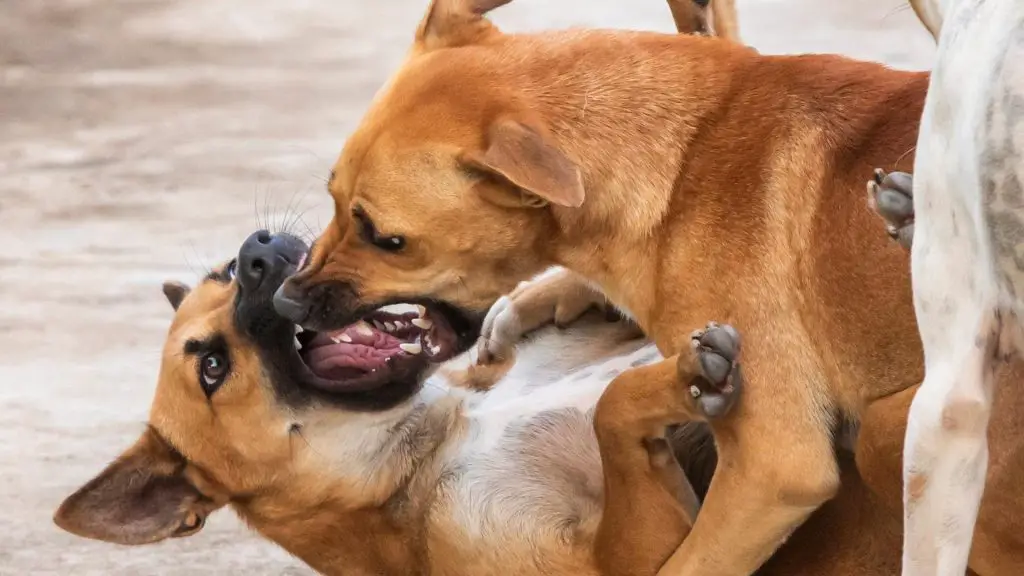
If a fight does break out between your dogs, how do you help them get along after the fight has calmed down?
The most important thing is to remain calm yourself. Dogs can sense when their owners are stressed so it’s important to stay relaxed and calm. You are the alpha in the pack, and they will look to you for guidance.
If it was dogs fighting over toys make sure to remove it from the equation. If it was dogs fighting over food, put their bowls in separate rooms.
Regardless of what they were fighting over let them both calm down separated. Once the dogs seem like they have calmed down, you can try reintroducing them in a neutral setting.
Most of the time after a fight they will go back to normal rather quickly. However, If the aggression persists keep them separated. Only when they both seem relaxed and comfortable with one another again should they be together.
The Danger Of Dogs Fighting In The House
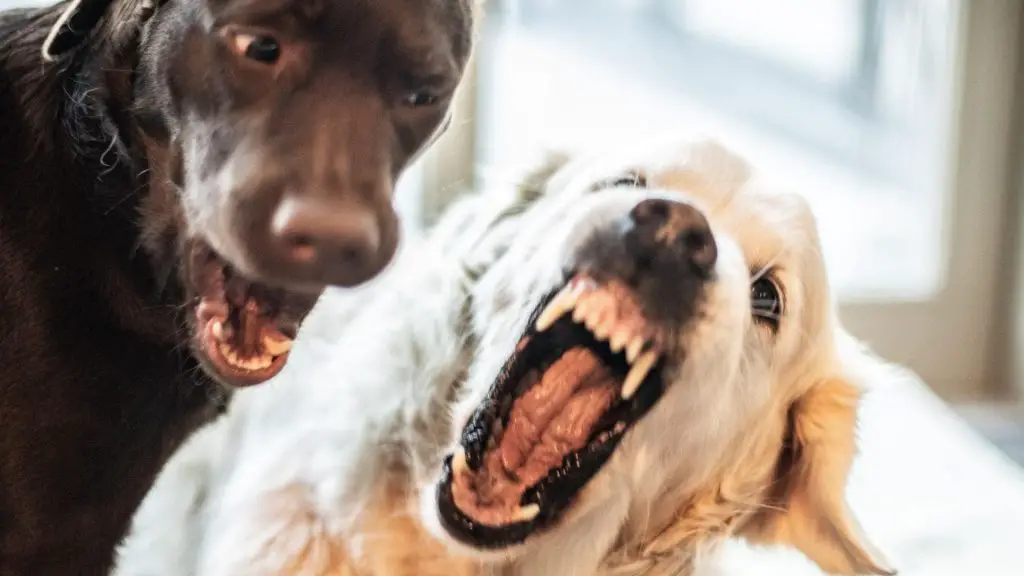
If you are constantly worried when the next fight will break out it can be tough on everyone in your home.
If this is the case you are probably in desperate need of a solution.
Dog fighting looks intense and aggressive, usually because they are.
Regardless of if the dogs are well matched in size or not, fights can lead to serious injury, costly vet bills, and in worst cases death.
When the risks are that high, you understand why training your dogs to share and get along is so important.
FAQs About Dogs Fighting At Home
Are My Dogs Fighting Or Playing?
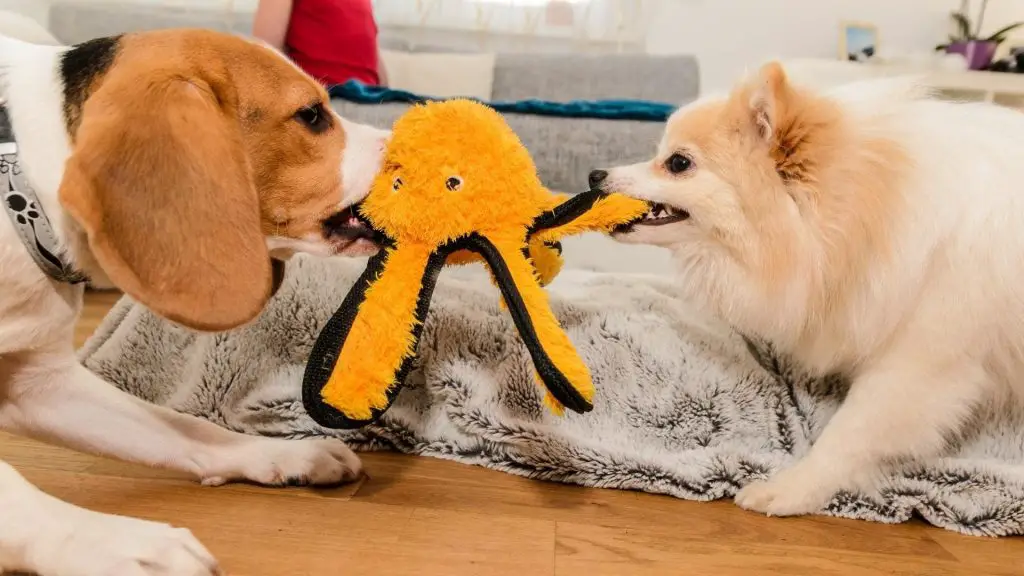
It can be hard to determine if dogs are play fighting or having a serious fight. The key is body language and level of engagement. While playing dogs can have their ears pinned, tail erect, teeth showing, and both dogs growling. It can often appear aggressive.
When play turns aggressive you can tell by the intensity, and stiffness in a dogs body language. There is also a very big distinction between a play bite and serious bite.
Another thing you can look for is bowing, bouncy energy, exaggerated movements, and sneezing. Sneezing is a dogs way to communicate to their play partner they want to keep it civil.
Is It Normal For Dogs That Live Together To Fight Sometimes?
Yes, its completely normal for dogs in the same pack to fight. Dogs have a hierarchy and in order to establish their position fighting may occur. This is why you as the alpha of the pack can step in to stop the fighting and keep your pack in line.
Why Has My Dog Become Aggressive Towards My Other Dog?
If you dogs have started fighting often and it appears one of your dog is the aggravator there are a couple reasons why this might happen. Your dog might be jealous, possessive, or is trying to change his position in the pack. If the fighting is becoming severe its important to take action immediately.
Final Thoughts
So there you have it! How to keep dogs from fighting in the same house is now accomplishable. It is no longer a helpless situation, you now have some guidance to solve the situation.
Keep in mind that no technique will be effective overnight. It takes time, dedication and patience.
As with anything, it’s a process but you WILL gain control and once you do, all the effort will be worth it.
I hope you found value in this information! Please share this post so we can help other dog owners solve this issue and keep our dogs of the world safe.
Other posts you might find interesting:
